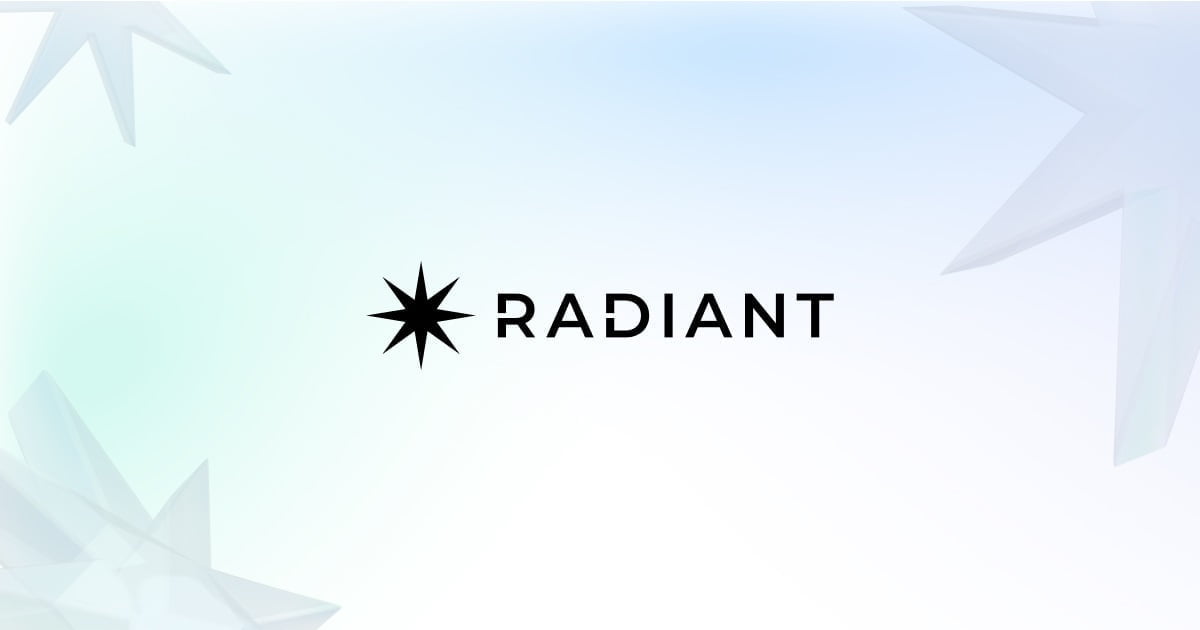Radiant Capital is a new player in the DeFi space, aiming to consolidate the fragmented liquidity across different chains and provide a seamless borrowing and lending experience.
This article offers a beginner’s guide to Radiant Capital, which includes essential information about its core offerings, security, Radiant v2, as well as terms and definitions associated with the platform and the native utility token $RDNT.
An Introduction to Radiant Capital
Radiant Capital is a decentralized finance (DeFi) platform that aims to bridge liquidity across different blockchain networks, including Ethereum, Binance Smart Chain, Polygon, and more.
It provides a seamless borrowing and lending experience for users while enabling them to earn yield on their assets. Radiant Capital’s omnichain approach enables users to easily move assets between different chains without having to go through a centralized exchange.
The platform also features a governance system that allows RDNT token holders to vote on important decisions and changes to the protocol.
The Problem with Fragmented Liquidity
Capital in DeFi is currently fragmented across different chains, which means lenders must decide on a chain, and the assets they withdraw must exist on that same chain.
This creates a suboptimal borrowing and lending experience, as users must navigate through a series of cumbersome transactions across multiple user endpoints.
The Solution: An Omnichain Money Market
Radiant Capital aims to be the first omnichain money market where users can deposit any major asset on any major chain and borrow various supported assets across multiple chains.
The Radiant DAO’s primary goal is to consolidate the ~$22 billion of fragmented liquidity dispersed across the top ten alternative layers.
Lenders and Borrowers Benefit
Lenders who provide liquidity to Radiant are interacting and providing utility to the platform. In addition, lenders can capture the added value from the communities’ engagement through the native token $RDNT.
Borrowers can withdraw against collateralized assets to obtain liquidity (working capital) without selling their assets and closing their positions. This means that Radiant Capital can offer competitive interest-bearing opportunities while maintaining a high degree of safety.
Security Audits and Resilience to Oracle Manipulation
Radiant V2 has been under development for over 1.5 years as the DAO strives to invent a new but necessary DeFi primitive (Also discussed below). Given the current state of alt L1s, Radiant launched v1 on what the DAO believes to be the most secure and decentralized blockchain – Arbitrum.
Radiant focuses on core offerings resilient to oracle manipulation and leverages the $2M+ already spent in security audits executed by Layer Zero & Stargate. Furthermore, it is worth noting that PeckShield and Solidity conducted a complete audit of Radiant v1, while Radiant v2 underwent audits by Peckshield, Zokyo, and Blocksec.
The $RDNT Native Utility Token
The Radiant DAO utilizes the native utility token, $RDNT. By interacting and providing utility to the platform, users can capture the added value from the communities’ engagement through the native utility token $RDNT from borrowers and platform fees.
Why Use Radiant Capital?
Traditionally, to get a loan, you’d need to go to a bank or other financial institution with lots of liquid cash and provide them with collateral. Radiant removes the intermediaries from asset trading, futures contracts, and savings accounts.
By interacting and providing utility to the platform, users can capture the added value from the communities’ engagement through the native utility token $RDNT from borrowers and platform fees.
Conclusion
Radiant Capital is a promising new player in the DeFi space, aiming to consolidate fragmented liquidity and provide a seamless borrowing and lending experience across multiple chains.
With a focus on core offerings resilient to oracle manipulation and a native utility token for added value, Radiant Capital is worth considering for your DeFi needs. Learn more about their most promising release below.
Radiant Unveils v2: A New Era in Decentralized Finance
Radiant has announced the launch of Radiant v2, a new era in decentralized finance (DeFi).
Most crypto projects do not operate profitable organizations, with 98% of crypto projects lacking revenue. However, in DeFi’s new narrative of sustainable “real yields”, the lack of revenue is not acceptable.
The goal of Radiant v2 is to be named the protocol with the lowest price to fee ratio in all of crypto while providing seamless omnichain lending. Token Terminal ranked Radiant Capital as the #1 “Fees to Market Cap” project in all of DeFi.
Radiant v2 Ecosystem
The combined brainpower of the DAO’s advisors, core contributors, and community means that this post is several years in the making after watching DeFi 1.0 and 2.0 unfold in a predictable fashion.
Radiant v2 is an ecosystem focused on preventing mercenary farming, introducing use cases with real utility for the future and longevity of DeFi, and true governance with fully implemented Discourse Discussion Boards and Snapshot voting.
Additionally, Radiant v2 supports 20+ new collateral options with extremely safe LTV limits, generating more platform fees for the DAO.
Radiant v1 Constraints
The elected counsel of the Radiant DAO has spent significant time in discussions with advisors and community members about how to address some of their earlier constraints in Radiant v1.
These constraints include unsustainable initial emissions that led to too much inflation, insufficient runway, a low incentive to provide on-chain liquidity to the protocol, suboptimal exit penalties, fixed unlock periods creating unnecessary FUD, and mercenary capital being incentivized.
Radiant v2 Changes
Radiant v2 includes revolutionary changes to core protocol mechanics, emissions, utility, and deeper cross-chain functionality. Radiant v2’s first priority will be to move the current ERC-20 RDNT token to the LayerZero OFT (Omnichain Fungible Token) format.
This migration will make cross-chain fee sharing much more seamless, enable quicker launches on additional chains, and permit native ownership of bridging contracts rather than relying on third-party bridges.
Treatment of Exit Penalties in v2
Radiant v2 will introduce changes to exit penalties, as users must either vest their RDNT emissions for 28 days or incur a 50% reduction in rewards. The new design ensures that users who exit on the final day of a vest are not penalized in the same way as someone who exits within the first minute of a vest.
This system forces users into a suboptimal binary decision. Consequently, it led to a high exit rate in the early days and highlighted the need for inert liquidity.
Radiant Capital: Common Terms and Definitions
If you’re new to the world of Radiant Capital, it’s easy to feel overwhelmed by the technical jargon and buzzwords surrounding this up-and-coming DeFi project.
But fear not! In this section, we’ll break down some of the most common terms and concepts related to Radiant Capital, so you can feel more confident navigating this exciting new landscape.
- Decentralized Finance (DeFi) – Decentralized finance, or DeFi, refers to financial applications that operate on a decentralized blockchain network. These applications are designed to be transparent, secure, and trustless, and they aim to eliminate intermediaries and central authorities in financial transactions.
- Blockchain – A blockchain is a decentralized digital ledger that records transactions and stores data in a secure, transparent, and immutable way. It is a distributed database that is maintained by a network of nodes, rather than a central authority.
- Liquidity – Liquidity refers to the ease with which an asset can be bought or sold in the market without affecting its price. In DeFi, liquidity is critical for the smooth functioning of the market, as it allows users to quickly buy or sell assets.
- Omnichain – Omnichain refers to the ability to move assets between different blockchain networks seamlessly. Radiant Capital’s omnichain approach enables users to easily move assets between different chains without having to go through a centralized exchange.
- Money Market – A money market is a financial market where short-term loans and investments are traded. In DeFi, a money market is a platform where users can lend and borrow assets and earn yield on their assets.
- Governance – Governance refers to the process of making decisions about how a decentralized protocol or organization operates. In Radiant Capital, RDNT token holders can vote on important decisions and changes to the protocol.
- RDNT – RDNT is the native utility token of Radiant Capital. Users can capture added value from the communities’ engagement through the native utility token RDNT from borrowers and platform fees.
- Collateral – Collateral refers to an asset that is pledged as security for a loan. In Radiant Capital, borrowers can withdraw against collateralized assets to obtain liquidity without selling their assets and closing their positions.
- Yield Farming – Yield farming refers to the process of earning rewards by providing liquidity to a DeFi platform. In Radiant Capital, lenders who provide liquidity to the platform can capture added value from the communities’ engagement through the native token RDNT.
- Smart Contract – A smart contract is a self-executing contract that is written in code and is stored on a blockchain. Smart contracts are used to automate and enforce the terms of a contract without the need for intermediaries or central authorities.
- Liquidity – Liquidity refers to the ease with which an asset can be bought or sold in the market without affecting its price. Radiant Capital helps its clients maintain a balance between liquidity and investment returns.
- FUD – An acronym for “Fear, Uncertainty, and Doubt,” FUD refers to a marketing or communication strategy that aims to create a negative perception of a competitor or industry in order to make one’s own product or service seem more desirable by comparison.
- DAO – Short for “Decentralized Autonomous Organization,” a DAO is a type of organization that operates using blockchain technology, with decision-making and governance processes that are distributed among its members rather than controlled by a central authority.
- OFT – An abbreviation for “Omnichain Fungible Token,” OFTs are tokens that can be exchanged for other tokens or assets on any blockchain platform, making them highly versatile and interoperable.
- LTV – LTV stands for “Loan-to-Value” and is a financial term used to describe the ratio of a loan amount to the value of the asset being used as collateral for the loan. In the context of Radiant Capital, LTV is an important factor in determining the maximum amount of loan that can be provided to a borrower based on the value of the assets being used as collateral. A higher LTV indicates a riskier loan, as the collateral may not fully cover the amount of the loan in the event of default.
Now that you’ve got a better understanding of some key terms and concepts related to Radiant Capital, you’re well on your way to exploring the full potential of this innovative DeFi project.
As always, be sure to do your own research and stay up-to-date on the latest developments in the space. Who knows? You might just discover the next big thing in crypto!
Final Word
Radiant v2 is poised to usher in a new era in DeFi with innovative features that solve the problems associated with DeFi 1.0 and 2.0.
The changes are focused on providing utility exchange between lenders/borrowers and the protocol and deciding who is eligible for the utility of receiving RDNT emissions.
These changes will enable Radiant to provide seamless cross-chain borrowing within minutes, generating more platform fees for the DAO.
Also Read: Best Legit Cryptocurrency Faucets You Can Trust
Well, what do you think about the article?
Did you enjoy reading “Radiant Capital for Beginners: An Omnichain Money Market“? If so, please comment down below. Your thoughts and opinions are valuable to us, so please feel free to leave a comment below to let us know if the information provided was helpful.
To see more content like this check the cryptocurrency section of Money For My Beer.

Chief Editor and Website Owner.
Hey, I’m Ryan, a software guy and the owner of Money For My Beer. I’m the one making sure all our posts on the site are awesome.
I usually handle tech stuff that might not be super interesting to everyone, like programming enterprise software, apps, games, and websites. Cool stuff, right? I also help clients with SEO and sometimes create games.

